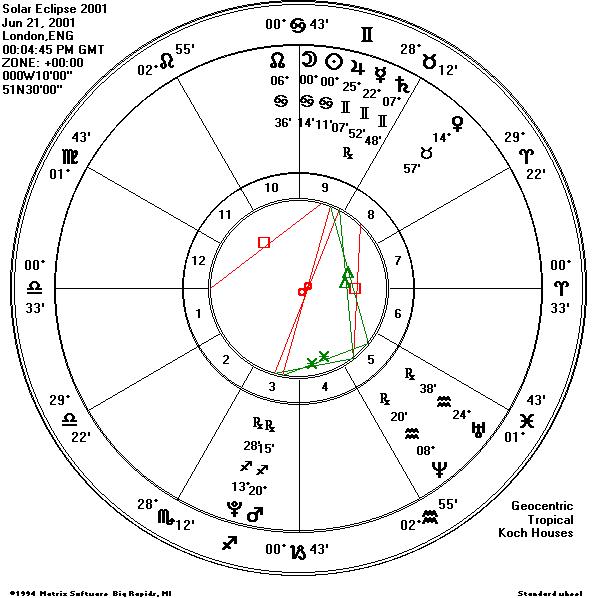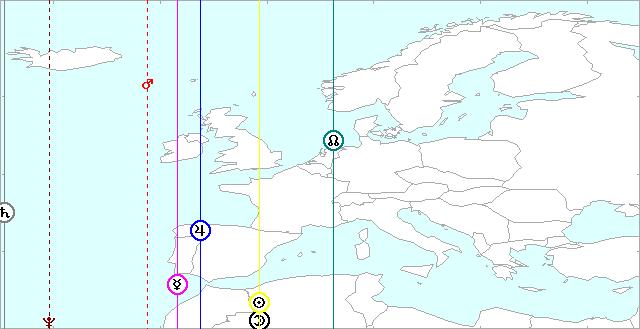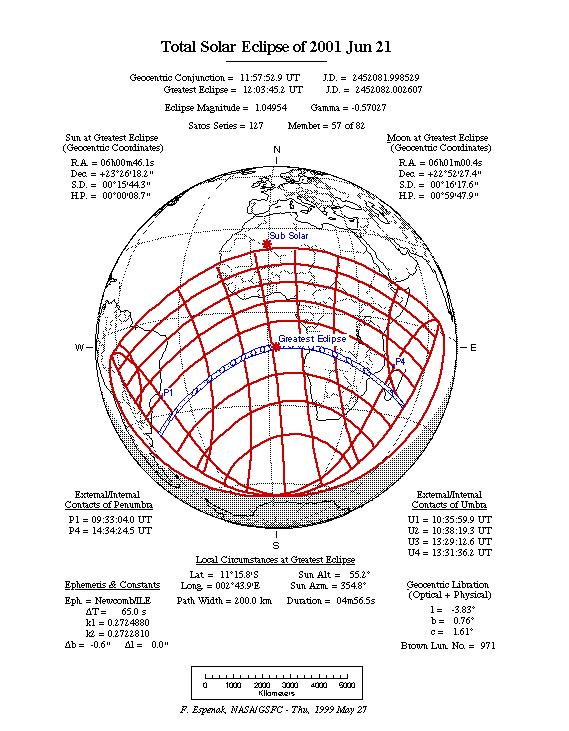
TOTAL SOLAR ECLIPSE

JUNE 21st 2001
THE ASTROLOGY OF THE EVENT.
Thursday June 21st 2001 has the astrological significance of the Summer Solstice followed by a Total Solar Eclipse in Cancer, occurring within five hours of each other. This day, all over the Earth, has epic potential. The astrological symbolism and meaning associated to this degree in the tropical Cancer, the Solstice degree, is of 'the release of the seed' or 'incarnation'. This is the start of the whirlpool of the past. A deeply emotional spirituality has at its point of conception this day in time.
The timings of this Eclipse.
The moment of Solstice occurs at 07-38 GMT.
The first penumbral contact of the eclipse occurs at 09-33 GMT.
Moon slips into Cancer at 11-41 GMT to join the Sun in Eclipse at tropical Zodiacal position 00 degrees minutes Cancer.
The moment of greatest Eclipse occurs at 12-04 GMT.
The eclipse is all over at 14-34 GMT.
At the moment of maximum eclipse the Sun and the Moon are exactly aligned to the MC of London. The same pair exactly align to the eastern horizons of Port Stanley in the Malvinas, and Mexico City. The Sun and Moon are setting at Rangoon, Burma, they are due west at Tehran. Jupiter conjuncts the MC at Tangiers, Belfast and Dublin. Mercury conjuncts the MC of the Phoenix Islands, and sets at Dacca. Pluto rises over Hyderabad, and is conjunct the IC of the Canary Islands, and is due west at Miami and Panama. and Uranus conjuncts the IC of Mauritius, which lies on the eclipse path, the MC of Vancouver, and the same planet is due west at Montivideo and Khartoumn, and due East at Seoul and at Shangkai. Saturn is due east at Tonga, due West at Aleppo in Syria. Venus is due west at Athens.
It appears from these EXACT planetary alignments that important developments of a new nature could be expected in the Malvinas. The UK is especially singled out for great social changes. Although not visible from the UK, this eclipse has a special alignment to the meridian of the UK.
The eclipse on June 21st is one of what is termed 'Saros series 127'. This series began on Oct. 4th 973 AD and will end after 2051 AD. This eclipse is member 57 of 82. The last eclipses in this series were in June 1983, May 1965, May 1947, May 1929... . This particular saros series is in the 'disseminating phase' as we enter the 21st century.


Thoughts on eclipses.
The study of Astrology can begin with a study of eclipses. The significance of eclipses is, in my view, central to the unfolding of the divine plan. The study of the zodiac, the ecliptic reference system, is a study of the personality of God. From this viewpoint all of what we label 'fate' or 'destiny' can be considered to be determined by the circumstances of eclipses, their timing, position, relationship to other eclipses, and their geometric relationship to the rest of the solar system and to the rest of the universe. During a Solar Eclipse events can be considered to be 'set up'. At the most central point of an eclipse of the Sun' a new 'seed message' is released within the biosphere of the Earth. (A similar but less powerful effect occurs at the moment of Mew Moon.) The meaning and substance of the new message ripples out forward and backwards in time forming shaping and influencing all events and processes at all levels. Everything that occurs at personal, national, and global realities have at their source the astrological seed message which emanated from the divine announcement of solar eclipses. During an eclipse of the moon fate or karma can be considered to reach a crescendo and a climax. At the central point of a lunar eclipse an all encompassing point of fulfilment of fate is reached. The 'note' sounded at this time pervades all matter and energy and radiates forwards and backwards in time, shaping, unravelling and reravelling, all events and experiences at all levels and in all kingdoms, in nature. (Again a similar and less powerful effect occurs at each full Moon). The divinity of all this phenomena is the central theme in this viewpoint. The idea that Eclipses influence events in both directions in real time, forwards and backwards, is not new but it is profound. At any time in a human lifetime and in the unfoldinding of the histories of the nations and peoples of the world, we are 'under the influence' of a number of eclipses. The eclipses immediately before us and behind us now, here, today, may have the greatest personal immediate effect. The eclipses closest in time on either side of our our own nativity, can, by employing the astrological ' day for a year' axiom of the 'secondary progression system', be understood to relate to the deeper unfolding of our own life story. In the world we are never further than about ninety days, forwards or backwards in time, from an eclipse of some sort. Using 'a day for a year' we can conclude that most of us of average human life expectancy can also expect for our life story to be deeply effected at some point by an eclipse which occurred near our own birth. Turning our attention now to longer time-period cycles, we are at any point in time, at some distinct phase of the astronomical eclipse cycle known as the SAROS CYCLE. If indeed eclipses are the mechanism of release and absorption of cosmic 'seed messages' and 'fulfilment of fate', then how much greater and holy are the messages associated with each Saros cycle. Each long term Saros cycle has its own long term message, a fractal of which is released and 'absorbed' at each eclipse in the series. I think that the purpose of the eclipse and the Saros 'process' may be one of the delivery of long term 'Messages from God'. The nature and meaning of each message, of each Saros Cycle, might be found in the astrological examination of the moment of maximum eclipse, at the time of, the first (and last) eclipse in each series. As in all cyclic manifestations, there is in each Saros, a point of origin, a waxing, a point of fulfilment, a waning, and quarter or 'crisis' points.
THE ASTRONOMY OF THE ECLIPSE.
(All following taken from:- http://sunearth.gsfc.nasa.gov/eclipse/eclipse.html)

The first total solar eclipse of the Third Millennium will be visible from within a narrow corridor that traverses the Southern Hemisphere. The path of the Moon's umbral shadow begins in the South Atlantic, crosses southern Africa and Madagascar, and ends at sunset in the Indian Ocean. A partial eclipse will be seen within the much broader path of the Moon's penumbral shadow, which includes eastern South America and the southern two thirds of Africa ().
The eclipse begins in the South Atlantic about 400 kilometres southeast of Uruguay. The Moon's umbral shadow first touches down on Earth at 10:35:55 UT. Along the sunrise terminator, the duration is 2m 6s as seen from the centre of the 127 kilometres wide path. During the next two hours, the umbra sweeps across the South Atlantic with no major landfall. The central duration, path width and Sun's altitude all steadily increase as the Moon's shadow rushes along its northeastern transoceanic course.
The instant of greatest eclipse occurs at 12:03:41 UT when the axis of the Moon's shadow passes closest to the centre of Earth (gamma = -0.570). The length of totality reaches its maximum duration of 4m 56s, the Sun's altitude is 55°, the path width is 200 kilometres and the umbra's velocity is 0.554 km/s. Unfortunately, these most favorable circumstances occur at sea some 1100 kilometres west of equatorial Africa's South Atlantic coastline ().
Another half-hour will elapse before the umbra reaches southern Africa. During this period, the duration and path width will slowly wane as the curvature of Earth carries the projected eclipse path away from the Moon. As a result, the tapering shadow cone will present a progressively narrower cross section to Earth's surface along the path of totality. Nevertheless, the 2001 total solar eclipse is over twice as long as the last total eclipse in 1999 at all corresponding positions along the path. Landfall finally occurs along the Atlantic coast of Angola at 12:36 UT. The centreline duration is 4m 36s, the path width is 193 kilometres and the Sun's altitude is 49°. Traveling with a ground speed of 0.63 km/s, the umbra swiftly moves eastward through the civil war torn nation. Although the weather prospects are excellent, Angola's political strife makes it a dangerous place for eclipse observers. By 12:57 UT, the shadow reaches the western border of Zambia where totality lasts a maximum of 4m 06s. The umbra's path is now directed to the east-southeast as it heads towards the nation's capital city. Lying about 40 km south of the centreline, Lusaka enjoys a total eclipse lasting a respectable 3m 14s. Further to the north, the centre line duration is 3m 35s and the Sun's altitude is 31°. Quickly crossing the Zambezi River, the path continues into Zimbabwe and Mozambique. The centreline runs near the border between these two nations for several hundred kilometres. Zimbabwe's capital city of Harare lies just 100 km south of the path, so its citizens will witness a partial eclipse of magnitude 0.976. As the umbra leaves Zimbabwe, it lies wholly within Mozambique for a minute before its leading edge reaches the shore of the Indian Ocean (~13:20 UT). At nearly the same time, its northern edge just skirts the southern border of Malawi. The centreline duration is now 3m 09s as the Sun's altitude drops to 23°. The shadow's speed has increased to 1.7 km/s as it begins to leave the continent for the open waters of the Indian Ocean.
One last major landfall remains as the umbra races over southern Madagascar. The eclipse occurs quite late in the day with the Sun just 11° above the western horizon. The central duration now stands at 2m 25s (13:28 UT) as the shadow's long elliptical projection stretches across the entire east-west breadth of the island. Continuing into the Indian Ocean, the umbra leaves Earth's surface (13:31:33 UT) as the path ends. Over the course of 2 hours and 54 minutes, the Moon's umbra travels along a path approximately 12,000 kilometres long and covering 0.3% of Earth's surface area.